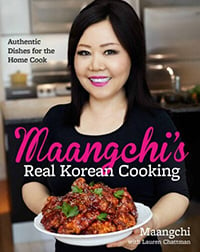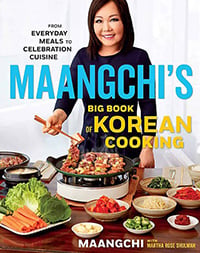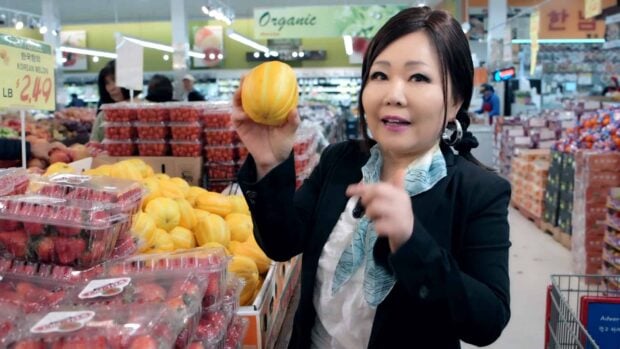These traditional Korean earthenware crocks can be used for making and preserving many things: soybean paste, soy sauce, hot pepper paste, fermented salty fish, makgeolli, and of course kimchi. They’re made from clay, and when fired leave microscopic holes that allow them to breathe, which makes them great for fermentation.
These crocks are called “onggi” which means “Korean earthenware” and technically includes the entire range of Korean pottery, tableware, and tools made by firing clay this way. But jars are the most common kind of onggi and most of the time, the word onggi means “earthenware crock.”
Many Koreans also refer to onggi by their size: danji (단지) is a small jar, hangari (항아리) a medium sized jar, and dok (독) is a large one. These jars can be made of anything, not just earthenware.
Traditionally, Korean pastes, sauces, and vegetables including kimchi were fermented in earthenware dok, which are a few feet high and kept outside in a corner of the yard set aside for this purpose, called the called a jangdokdae. Jang, or sauces, were kept in jangdok and kimchi in kimchidok. Kimchi crocks were often buried underground in winter, so the kimchi inside didn’t freeze.
Cleaning an onggi
Don’t use any soap or detergent to clean an earthenware crock because soap will get into the microscopic holes and eventually get into your food. So wash with only cold, warm or hot water, and scrub it well. Rinse a couple of times and dry it well with a kitchen towel and then set it out to air dry.
Some smells will remain even after washing, so if this bothers you give it a deeper cleaning by filling it with hot water and letting it sit for 24 hours. Then pour out the water and fill it up again and let it sit another 24 hours. You can do this until you’re satisfied that it’s clean and doesn’t smell at all.
I keep an onggi exclusively reserved for making rice beer (makgeolli), which otherwise sits empty. I can use the same onggi to make soy sauce or doenjang or fish sauce because all of them are fermented and pungent, and once a crock has been used to make those things the smell never totally goes away from it. For this reason I keep one onggi reserved for makgeolli and never use it for anything else, because I don’t want that flavor in my drink.











Hello! I’m new here but i’ve been cooking Korean food for a long time! I love it all! I purchased a few earthenware pots and I found that they all leak. Is anyone else having issues like this? Is this happening because the material is porous?
Hello.
Thank you for your very informative YouTube videos.
I live in the UK and I have been in search of a shop that sells Onggi of 5L and 7L sizes to make and store fermentions but I have not been successful.
All the shops I have found here and online sell only very small ones and very expensively.
Do you know of anywhere in the UK that specifically sells these pots?
I want to purchase a large quantity.
or alternatively, a Korean supplier that can sell 10 of each size? (Alibaba is very expensive on delivery)
Many thanks.
Mojee
Hi Maangchi
I love your shows on you tube. And I wanna try making your simplified version of kimchi. As I am from Malaysia which is a humid and hot country is it advisable to store kimchi in a onggi at room temperature. Temperature should be 30 to 32 degree Celsius. Or best to keep kimchi in plastic tub in fridge? Looking forward to your advise before I purchase the onggior make kimchi. Gamsahamnida.
You can store your kimchi in a plastic container, glass jar, or in an earthenware(onggi) jar but you should refrigerate the kimchi. Malaysia is warm, so it will take only 1 day to ferment your kimchi. When the kimchi is fermented, it tastes and smells sour. Then transfer it to the fridge. Or refrigerate your freshly made kimchi right after making it. It will take 10- to 14 days to ferment the kimchi in the fridge. By the way, you can eat your kimchi anytime.
Gamsahamnida Maangchi. Will be making this coming Saturday. Going to find plastic container as it fits better in the fridge. Will show you the picture soon.
A young haseyo Maangchi
Just finish making the Kimchi. Attached is the picture.
See full size image
It’s funny, that in middle Europe it’s tradition to make fermented sour cabbage, it’s just not spicy and we use very similar jars to keep it in.
See full size image
Thank you for sharing the photo! Yeah, very similar!
Maangchi,
I live in mid-Delaware, far from any Asian Grocery stores. I’ve wanted to find a Hangari Onggi pot for making Magkeoli. Hangari Onggi pots are difficult to find anywhere, and impossible to find w/i easy driving distance from me. Until yesterday. I learned of and drove to Young’s Oriental Market in Wilmington, Delaware for the first time, and found a good supply of Onggi pots, all sizes. Bought my beautiful Hangari and a bunch of other ingredients.
Young’s is relatively small (in footprint only) and chocked FULL of anything one would want for Korean/Asian cooking and eating. The staff people there were extremely helpful and answered all my questions easily. Highly recommend the store for anyone living within driving distance. I don’t believe they do any mail order, but not sure.
Thanks for your two beautiful books.
JEL
Would white vinegar also be a good thing to use to remove bad smells from an onggi?
I’ve used white vinegar to remove smells from my food containers and lunchboxes.
“Hello everybody”, I am new here and wanted to share the talented Onggi maker that I bought my crocks from. He is Adam Fields and lives in Montana, US. He studied in Korea and makes beautiful and affordable onggi, if you are seeking pots please check him out!!! https://www.facebook.com/adamfieldpottery
Hello Maangchi & Everyone,
I’m looking for the Korean earthenware bow that is used to mix kimchi. It looks like an Onggi lid but I don’t know what it’s called or where to buy it. Thanks!
Hello Maangchi! I would like to know if onggi are oven safe? I know they are not intended for use in the oven, but I have several of them and was thinking of using one of them to make and store confit, which is cooked at a low oven temperature, about 225F. What do you think?
Hello:
Does anyone know firsthand whether I can find onggi at the E-Mart near Grand Hyatt Incheon? Thank you.
Helloooo!
Trying to find Korean Earthenware in Sweden, without success. I made both Kimchi and Soy souse in glass containers, hmm, not the same thing.
Does anyone know where to purchase Onggi’s in Europe? Need 3-5 gallon size. Several of them. Thank you in advance!
Hi, you can get onggis in Germany in Düsseldorf at Dae Yang’s. The shop is placed on Little Japan’s Immermannstraße. They have several sizes in store. They also have an internet homepage (www.dae-yang.de), so you should be able to at least contact the owners. The onggis are not listed on the homepage though as far as I could see. Also, the shop is family owned and I don’t know how much time this busy family is able to spend for their internet business.
But should the occasion arise to come to Düsseldorf, please do so. Dae Yang is not the only shop around, there are several other Korean shops, most remarkable Hanaro Market, also on Immermannstraße.
Hi Maangchi! I’ve been looking all over for a large dok and maybe a few hangari and I’ve had no luck, even here in New York! I know that there are several small ones on amazon, but we’re really just interested in larger ones. Do you have any suggestions where we might find them? Thanks!
Hi Maangchi,
I’m almost frustrated finding a huge (2feet tall at least) Hangari/Onggi “Dok”, to be shipped to my country Kuwait. I didn’t find an importer online that fits my requirement. Please guide me on how I can acquire the largest possible Dok vessel. I love Korean food and would like to make my own soy sauce and kimchi, using the most traditional method.
Thanks&shops your early reply:-)
Trying to find a place to buy one large enough to make this…please help me!
Needs to be at least 8 quart for makgeolli…
Hi Maangchi,
I was thinking of buying a small onggi pot for kimchi at a Korean supermarket. Are they expensive?
Thank you!
I found a 16.23oc one on amazon for 24.99 so you can find them, and they aren’t that expensive.
Where can you locate them? As the previous post states they are hard to find.
Amazon sells them. found a 16.23oz one for 24.99
The small ones run from 20 dollars. (the 4 inch ones are around 10-15) and the medium ones good for one head of kimchi are about 30. The large ones can run up to 80. the ones in the K-drama where they are in the yard are more like 100 bucks.
I had hell trying to find mine.
Hi I am just new here!..^^, how much is the small onggi pots? I am interested in making my own Kimchi..please help me..thanks!..^^,